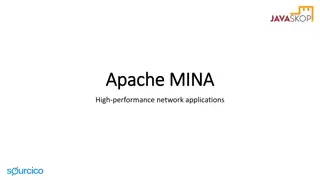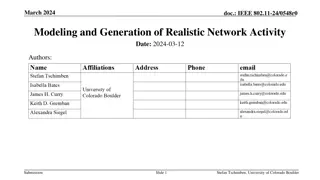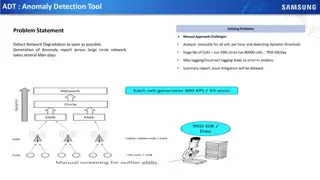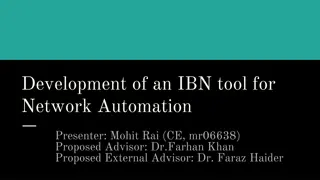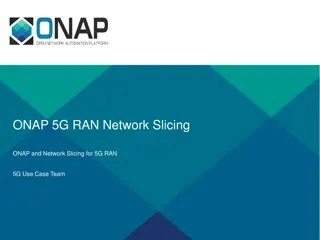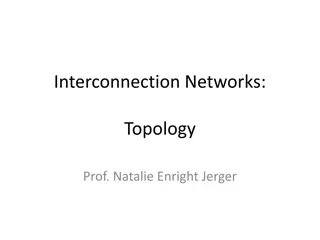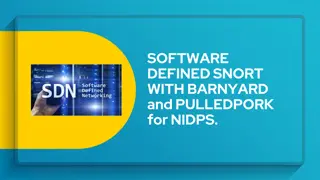
Network Connectivity
Explore the world of network connectivity with this detailed guide covering devices like Network Interface Cards (NICs), hubs, repeaters, switches, and more. Learn about their functions, advantages, and limitations to enhance your knowledge of networking fundamentals.
Uploaded on | 0 Views
Download Presentation

Please find below an Image/Link to download the presentation.
The content on the website is provided AS IS for your information and personal use only. It may not be sold, licensed, or shared on other websites without obtaining consent from the author. If you encounter any issues during the download, it is possible that the publisher has removed the file from their server.
You are allowed to download the files provided on this website for personal or commercial use, subject to the condition that they are used lawfully. All files are the property of their respective owners.
The content on the website is provided AS IS for your information and personal use only. It may not be sold, licensed, or shared on other websites without obtaining consent from the author.
E N D
Presentation Transcript
NETWORK CONNECTIVITY Mrs. Meenakshi, Lecturer ECE
Connectivity devices The Network Interface card (NIC) The hub The repeaters The switch The bridge Transceivers Wireless access points The router The gateway
Network Interface Card (NIC) The Network Interface Card (NIC) used connect the computer to the external network.It will normally have a PCI connector (Edge connector) to connect to one of the PC expansion slots, and an RJ-45 connector to connect to external Ethernet. Note that the interface connectors may differ depending upon the expansion bus being used (for example, PCI, ISA, EISA, USB etc.), and the networking media being used (for example, 10Base2, 10Base5, 10BaseT, etc.). Each of these have their own interface specifications. Almost all NICs have LED indicators showing the network connectivity.
Repeater A repeater operates at the physical layer.Its job is to regenerate the signal over the same network before the signal becomes too weak or corrupted so as to extend the length to which the signal can be transmitted over the same network. An important point to be noted about repeaters is that they do not amplify the signal. When the signal becomes weak,they copy the signal bit by bit and regenerate it at the original strength. It is a 2 port device.
Hub A hub is basically a multiport repeater.A hub connects multiple different branches, connector in star topology which connects different stations. Hubs cannot filter data, so data packets are sent to all connected devices. In other words, collision domain of all hosts connected through Hub remains one. Also, they do not have intelligence to find out best path for data packets which leads to inefficiencies and wastage wires for coming example, from the
Hub: A Hub connects all the nodes of a network using Twisted Pair (UTP or STP) cables. In a Hub, the signals received on one port are transmitted to all other ports, and vice versa. All nodes (work stations) connected using a Hub can listen to one another all the time. The advantage of using a Hub is low cost, and easy integration. The disadvantage is reduced bandwidth, and data security. The reduction in bandwidth comes due to the fact that all workstations are in the same collision domain. If two or more workstations try to transmit during the same time, it results in collision of signals, and the signals are lost altogether. As a result, the available bandwidth of the Ethernet network is reduced.
Types of Hub Active Hub:- These are the hubs which have their own power supply and can clean, boost and relay the signal along with the network. It serves both as a repeater as well as wiring center. These are used to extend the maximum distance between nodes. Passive Hub :- These are the hubs which collect wiring from nodes and power supply from active hub. These hubs relay signals onto the network without cleaning and boosting them and can t be used to extend the distance between nodes.
Switch A switch is a multiport bridge with a buffer and a design that can boost its efficiency(a large number of ports imply less traffic) and performance. A switch is a data link layer device. The switch can perform error checking before forwarding data, that makes it very efficient as it does not forward packets that have errors and forward good packets selectively to correct port only. In other words, switch divides collision domain of hosts, but broadcast domain remains same.
48-port Switch A Switch, on the other hand, do not distribute verifying whether it really needs to propagate to a given port or ports. It decides it based on its internal configuration We can say that a Switch is a Hub with some intelligence. signals without settings.
Bridge A bridge operates at data link layer. A bridge is a repeater, with add on the functionality of filtering reading the MAC addresses of source and destination. It is interconnecting two LANs working on the same protocol. It has a single input and single output port, thus making it a 2 port device content by also used for
Contd.. A Bridge functions very similar to a Switch. It segments a given network according to the requirements. Segmentation enables keeping un-intended traffic from entering different segments of a network. Both Bridge, and Switch are OSI layer-2 devices. Bridges filter traffic based on the destination address of the frame. If a frame's destination is a node on the same segment where it originated, it is not forwarded. If it is destined for a node on another LAN, it is connected to corresponding bridge port and forwarded to that port. using a Bridge
Types of Bridges Transparent Bridges:- These are the bridge in which the stations are completely unaware of the bridge s existence i.e. whether or not a bridge is added or deleted reconfiguration of the stations is unnecessary. These bridges make use of two processes i.e. bridge forwarding and bridge learning. Source Routing Bridges:- In these bridges, routing operation is performed by source station and the frame specifies which route to follow.The hot can discover frame by sending a special frame called discovery frame,which spreads through the entire network using all possible paths to destination from the network,
Routers A router is a device like a switch that routes data packets based on their IP addresses. Router is mainly a Network Layer device. Routers normally connect LANs and WANs together and have a dynamically updating routing table based on which they make decisions on routing the data packets. Router divide broadcast domains of hosts connected through it.
Contd.. A Router connects multiple networks, and uses routing to forward packets. It is a OSI Layer-3 device and works on the logical address of a host or a node. Compare this with a Switch which works on the physical address (such as MAC address) of a host or a node
B-router It is also known as bridging router is a device which combines features of both bridge and router. It can work either at data link layer or at network layer. Working as router, it is capable of routing packets across networks and working as bridge, it is capable of filtering local area network traffic.
Gateway A gateway, as the name suggests, is a passage to connect together that may work upon different networking models.They basically work as the messenger agents that take data from one system, interpret it, and transfer it to another system. Gateways are also called protocol converters and can operate at any network layer. Gateways are generally more complex than switch or router. two networks
Contd.. Gateways are the most complex devices with respect to the functionality. They typically work at the upper most layers of OSI model. A gateway is used to connect two different environments, such as a Frame-Relay network network. and an X.25
Wireless Access Points (WAP) A wireless access point allows mobile users to connect to a central network node without using any connectivity is useful workstations, since involved. The wireless access standards are broadly divided into 802.11a, 802.11b, and 802.11g. 802.11g is most popular among these due to high bandwidth that it provides, and the availability commercially available wireless access point is shown in the figure below. wires . Wireless mobile no wiring for is there of hardware. A
WAN devices Other network connectivity devices that may be not directly participating in moving network data are: Modems ISDN terminal adapters CSU/DSU
Modems The Term Modem is the acronym of Modulator/De-Modulator.There are several types of modems.These include: 1.Dial-upAnalog Modem 2.Broadband Modem
Contd.. Analog modems are widely used to connect to the Internet using normal telephone lines. These modems use the same frequencies used for voice transmission. Therefore, you can not make a call or receive a call (voice call) when using this modem to connect to the Internet. Broadband modems use a different technology to connect to the central office. They do not use the voice frequencies to communicate over the telephone wire. As a result, you can make or receive voice call when using broadband modem. Another advantage using broadband modem is speed. Speeds of several megabits per second are typical using broadband modems, where as it is limited to 56 kbps (or so) when using analog modems.
Modem Front panel Back panel
ISDN terminal adapters: It is short form for Integrated Service Digital Network (ISDN). It delivers digital services over conventional wires. You can connect your phone to an ISDN line using a terminal adapter (TA). An ISDN modem provides higher speeds compared to analog modems, but far less speed when compared to broadband modems. telephone
ROUTING PROTOCOLS Routing protocols are the set of rules used by the routers to communicate between source & destination. They do not move the information source to update the routing table. Each protocol has its own algorithm to choose the best path. The metrics by routing protocols:- Number of network layer devices along with the path (hop count) Bandwidth Delay Load destination only
STATIC ROUTING PROTOCOLS Static routing ,when an administrator manually assigns the path from source to destination network. This is feasible in small networks, but not in large networks. Advantages:- No overhead on router CPU. No bandwidth usage between links. Security (only administrator add routes.) Disadvantages:- All link will be down on a link failure. Not practical on large networks. Administrator must update allroutes.
DEFAULT ROUTING PROTOCOLS Default Route is the network route used by a router when there is no other known route exists for a given IP datagram s destination address. All the IP datagrams with unknown destination address are sent to the defaultroute. Advantages:- No overhead on router CPU. No bandwidth usage between links. Security (only administrator addroutes.) Disadvantages:- All link will be down on a linkfailure. Not practical on largenetworks. Administrator must update all routes.
DYNAMIC ROUTING PROTOCOLS Dynamic routing is the process in which routing tables are automatically updates by routing table of each neighbor. Dynamically discover & maintainsroutes. Calculate routes Advantages Less work in maintaining the configuration when adding & deletingnetworks. Protocols automatically react to the topology changes. Configuration is less-prone. Disadvantages Routers resource are used. More administrator knowledge is required forconfiguration
RIP It allows routers to exchange their routing tables at a predefined interval. It is a distance-vector routing protocol which employs the hop count as a routing metric. It transmitted updates in every 30 seconds. CHARACTERISTICS: - Uses hop count metric Supports 15 hop-count limit AD value is 120. Supports classful networks.
RIP v2 o It is a Extended version of RIP routing protocol. o Maximum hop count is 15. o Supports small network o Supports classless network. o Supports VLSM/CIDR. o Supports Auto-Summarization. o Route updates after 30 sec. o It supports Key-authentication.

